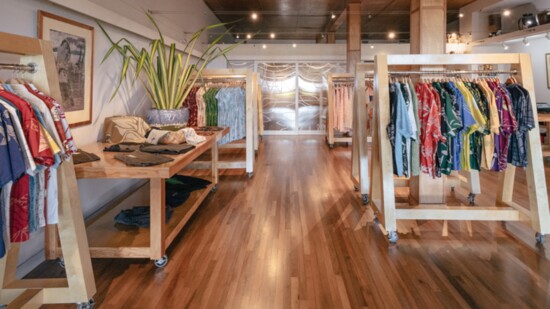If you’ve ever seen a green and white “Live Aloha” bumper sticker with a little lehua leaf, you already know about Sig Zane Designs. However, not many people knew what a lehua leaf looked like when that sticker emerged a few decades ago. As that campaign grew and gained recognition, the organic image became a Hawaiian icon. This is the story of the family-owned clothing company that turned culture into a fashion statement, proving that the past is still alive.
Sig Zane and his wife Nalani Kanakaʻole have been talented artists since they were young. Nalani taught hula, while Sig expressed himself through wood carving. When they saw the impact of aloha wear in the world, they realized the clothes didn’t necessarily represent the heart of Hawai’i. Suddenly, the combination of their gifts created the opportunity to educate others through design and contribute to understanding this land’s heritage.
In 1985, Sig Zane Designs was born. The couple learned Hawaiian culture's intricacies from the hula they danced and proceeded to hand-print Sig’s hand-cut artwork in fabrics that became products like aloha shirts, t-shirts, and pareu. The lines, patterns, and textures are an ode to the past and a minimalistic gift to future generations.
“Though my dad is the CEO, his essential role is that he is still the artist of the company. Ninety-nine percent of the artwork you see for our projects or products comes from his hand-crafted artwork,” says Kūha'o Zane, Creative Director of Sig Zane Designs.
Even today, Sig and Nalani work as a team. Nalani is a teacher at Hālau o Kekuhi, an eighth-generation hula school. Her contribution is diving into different cultural studies and analyzing what they mean to society today. Every Indigenous group has a different type of intelligence documented in stories, chants, or cultural practices. From the beginning, Sig’s goal has been to figure out how to share this Indigenous intelligence and stories visually.
Kūha'o inherited his parents' passion and attended design school. He describes his function in the company as taking the cultural and aesthetic narrative that has been passed down and figuring out the best product that will be able to continue their mission of cultural education.
When asked about his favorite designs, Kūha'o shares his father’s ʻōhiʻa lehua prints are at the top of the list because of their importance to Hawai’i’s water systems. “ʻŌhiʻa lehua is one of the main feeders of our aquifers here on the island. If you drink the water here on this island, you should also assign the same importance to the lehua plant. In the 80s or 70s, lehua wasn’t a concept as it is now. In a small way, Sig Zane, both through his artwork and company, contributed to lehua being a recognizable image,” he says.
After 20 years with the company, what Kūha'o is most proud of is not a specific design, but the workshops Sig Zane Designs offers to educate its staff. Some of that training involves 'ohe kāpala, a bamboo stamp style with a Hawaiian aesthetic in the format of a bamboo stick. “Cutting into bamboo is pretty difficult already as you are designing it. But the cool thing about 'ohe kāpala is that it also tells a story through the design you add to the bamboo. So we try to choose different chant lines or stories and then add the design,” he shares.
As an artist with plenty of experience, Kūha'o has some advice for those who aspire to become graphic, fashion, or interior designers in Hawai’i. According to him, an immense amount of generational knowledge and systems built into the culture can serve and solve many problems. This includes not only design issues, but also environmental problems that can be fixed just by looking through the Hawaiian lens offered to us as dwellers on this land.
“Whoever you are out there, if you are curious about Hawai’i and see this land as an inspiration, learn from it. Many times, industry people come and get inspired by Hawai’i but do not actually partner with Hawai’i. So, if you are inspired, come talk to people from the land,” he adds.
Kūha'o shares that the most significant thing someone can do is to tap into the Hawaiian language. As we live in an era where language apps are at everyone’s reach, nothing can stop us from being able to learn it. One aspect that makes Hawaiian language unique is that one word can have multiple meanings. As a result, when words are put together into a sentence, they become a network of meaning. “It may just look like four or five words, but it’ll have multiple levels or multitudes of meaning to work through,” he says.
But art is not just an expression of the soul; it comes with strings attached. It must be faithful to what inspired it and the kuleana of its influence. Sig Zane Designs has learned and applied this concept for the past four decades and can be replicated by every resident and visitor of these islands. All we have to do is ask ourselves what we can do to deserve to live here?
“When you think about it in that matter, it changes the paradigm a little. Many people think that if they have enough of a salary or enough to pay for their lifestyle, they deserve to live here. But the land doesn't benefit from our salaries. So, how can we pay back to the land? It has to be in a currency taken by the land, and some of the best people who understand the land's currency are the Hawaiians. Learn from them,” Kūha'o says.
Discover more at SigZaneDesigns.com.
"Ninety-nine percent of the artwork you see for our projects or products comes from his hand-crafted artwork,” says Kūha'o Zane, creative director of Sig Zane Designs.
Many times, industry people come and get inspired by Hawai’i but do not actually partner with Hawai’i.
